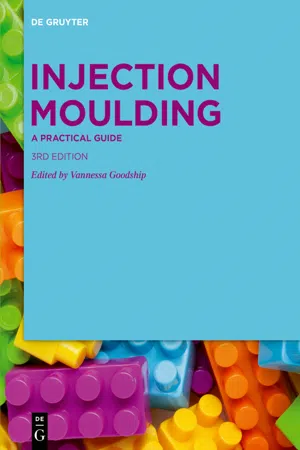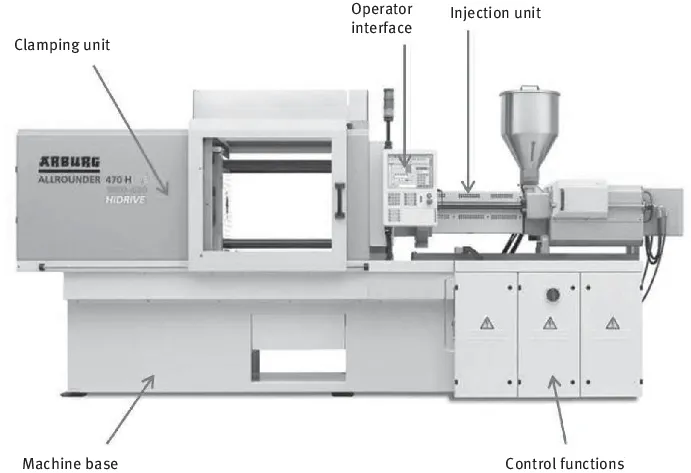
eBook - ePub
Injection Moulding
A Practical Guide
Vannessa Goodship, Vannessa Goodship
This is a test
- 416 pages
- English
- ePUB (adapté aux mobiles)
- Disponible sur iOS et Android
eBook - ePub
Injection Moulding
A Practical Guide
Vannessa Goodship, Vannessa Goodship
Détails du livre
Aperçu du livre
Table des matières
Citations
À propos de ce livre
This revised 3rd edition details the factors involved in the injection moulding process, from material properties and selection to troubleshooting faults, and includes the equipment types currently in use and machine settings for different types of plastics. Since material flow is critical in moulding, the book covers rheology and viscosity. High temperature is also discussed as it can lead to poor quality mouldings due to material degradation.
Foire aux questions
Comment puis-je résilier mon abonnement ?
Il vous suffit de vous rendre dans la section compte dans paramètres et de cliquer sur « Résilier l’abonnement ». C’est aussi simple que cela ! Une fois que vous aurez résilié votre abonnement, il restera actif pour le reste de la période pour laquelle vous avez payé. Découvrez-en plus ici.
Puis-je / comment puis-je télécharger des livres ?
Pour le moment, tous nos livres en format ePub adaptés aux mobiles peuvent être téléchargés via l’application. La plupart de nos PDF sont également disponibles en téléchargement et les autres seront téléchargeables très prochainement. Découvrez-en plus ici.
Quelle est la différence entre les formules tarifaires ?
Les deux abonnements vous donnent un accès complet à la bibliothèque et à toutes les fonctionnalités de Perlego. Les seules différences sont les tarifs ainsi que la période d’abonnement : avec l’abonnement annuel, vous économiserez environ 30 % par rapport à 12 mois d’abonnement mensuel.
Qu’est-ce que Perlego ?
Nous sommes un service d’abonnement à des ouvrages universitaires en ligne, où vous pouvez accéder à toute une bibliothèque pour un prix inférieur à celui d’un seul livre par mois. Avec plus d’un million de livres sur plus de 1 000 sujets, nous avons ce qu’il vous faut ! Découvrez-en plus ici.
Prenez-vous en charge la synthèse vocale ?
Recherchez le symbole Écouter sur votre prochain livre pour voir si vous pouvez l’écouter. L’outil Écouter lit le texte à haute voix pour vous, en surlignant le passage qui est en cours de lecture. Vous pouvez le mettre sur pause, l’accélérer ou le ralentir. Découvrez-en plus ici.
Est-ce que Injection Moulding est un PDF/ePUB en ligne ?
Oui, vous pouvez accéder à Injection Moulding par Vannessa Goodship, Vannessa Goodship en format PDF et/ou ePUB ainsi qu’à d’autres livres populaires dans Sciences physiques et Chimie industrielle et technique. Nous disposons de plus d’un million d’ouvrages à découvrir dans notre catalogue.
Informations
1 Introduction
1.1 The big picture
When the Hyatt brothers, John and Isaiah, built and patented the first injection moulding machine (IJM) in 1872, it is doubtful they could possibly have imagined the impact this invention would have on the world. It spawned a worldwide industry employing millions of people.
In 2013, plastic manufacturers generated over 373 billion US dollars (USD) in the US alone with the plastic industry employing 900,000 people there. The worldwide consumption of plastic materials rose from 245 million metric tonnes in 2008, to 311 million metric tonnes in 2014. China uses over a quarter of the world’s plastics, with this figure increasing year on year as manufacturing grows. Europe’s manufacturing base is the second largest global market consuming around 20%. The Chinese market is increasingly prominent across the entire plastics sector and China is currently both the largest producer of machines in the world and the biggest consumer of them, which drives the need for a plastic raw materials market as well.
IJM sales in China had reached a market worth 25.5 billion Chinese yuan [renminbi (RMB)] in 2013, and was expected to reach RMB30 billion by 2016.
The packaging sector accounts for the majority of the world market, with the automotive industry and the electrical equipment industry also both heavy consumers of plastic and injection mouldings. Other important markets for plastic materials are the construction industry and consumer products.
A major factor for the entire injection moulding industry (and manufacturing in general) has been the globalisation of the market. Like other industries, successful IJM manufacturers have kept pace with changes in global demand and moved to lower cost production plants in the world’s developing economies, such as China, India and Brazil. To adapt to the increased competition, the successful manufacturers are the ones that have been able to adapt, innovate and compete.
From these few facts and figures it can be seen that injection moulding is an extremely large and important manufacturing industry, but what is injection moulding?
1.2 Introduction to injection moulding
Injection moulding is one of the most commonly employed processes to produce plastic parts. It is a cyclic process of rapid mould filling followed by cooling and ejection. A variety of materials both plastic and non-plastic can be used as feedstock; however, the machine must be configured for the type of material used.
The material, which is generally available as grains or powder, is plasticised in an injection unit and injected into a clamped mould under high pressure (500–1,500 bar). The main advantage of injection moulding is it is a very economical method of mass production. Ready parts with tight tolerances can be produced in one step, often completely automatically and, in general, subsequent processing steps are not necessary. It is also possible to integrate different functions into one part to avoid the formation of different components that would be more expensive, and some of these more advanced and integrated processes are discussed in Chapter 10.
To guarantee a high-quality injection moulded part the following points have to be considered:
- The material has to be plasticised and injected carefully to avoid negative effects on the properties and characteristics of the material.
- The process settings (such as pressures and temperatures) concerning the machine and mould have to remain constant with regard to time and space.
An example of a commercially available IJM is shown in Figure 1.1 and the basic parts that make up a machine are shown in Figure 1.2.

Figure 1.1: An injection moulding machine (IJM).

Figure 1.2: Basic components of an IJM.
The computer control unit allows the machine operator to control and monitor the process; control systems will be discussed in Chapter 5.
The purpose of the injection unit is to melt and meter the material into the tool; machinery will be discussed in Chapter 3.
The clamp unit holds the injection moulding tool and gives the required clamp force to hold the two sides of the mould tool together; tooling will be discussed in Chapter 4.
The machine base is powered by either electrical or hydraulic means, and houses the systems that drive the movement of the machine. Each machine has a certain ‘footprint’, which is the floor space it requires for operation.
1.3 The injection moulding process
During the injection moulding process, the mould and the plasticising area are separated from each other. The temperature of the plasticising area, i.e., the plasticising cylinder, is maintained at the same level as the processing temperature. The mould on the other hand, is kept cold enough for demoulding of the injection moulded part (thermoplastics), or warm enough for crosslinking (thermosets). The plasticised material is injected into the clamped mould. In an IJM, the clamping unit, which contains the mould and injection unit, is integrated. Completely automated production is possible if the mould is installed with a vertical parting line, which enables the parts to fall down and out of the mould after demoulding. IJM are more typically used for the processing of thermoplastics. There are two types of injection unit available: a piston injection unit and a screw piston injection unit (reciprocating); the reciprocating screw method is the most common. Only screw piston machines can be used for the processing of thermosets as without the screw, the dwell time would be too long and the risk of early crosslinking would be too high. The injection sequence for both types of machine now follows.
1.3.1 Piston injection unit
Injection sequence:
- Injection starts (clamped mo...
Table des matières
- Title Page
- Copyright
- Contents
- Preface
- 1 Introduction
- 2 Introduction to plastics
- 3 Injection moulding machinery
- 4 Injection mould tooling basics
- 5 Process control systems
- 6 Amorphous and semi-crystalline thermoplastics
- 7 Processing thermoset, liquid silicone rubber and ceramic materials
- 8 Guide values and processing instructions for the most important thermoplastic injection moulding compounds
- 9 Practical applications using injection moulding technology
- 10 Advanced processing techniques
- Abbreviations
- Index
Normes de citation pour Injection Moulding
APA 6 Citation
[author missing]. (2020). Injection Moulding (3rd ed.). De Gruyter. Retrieved from https://www.perlego.com/book/1449260/injection-moulding-a-practical-guide-pdf (Original work published 2020)
Chicago Citation
[author missing]. (2020) 2020. Injection Moulding. 3rd ed. De Gruyter. https://www.perlego.com/book/1449260/injection-moulding-a-practical-guide-pdf.
Harvard Citation
[author missing] (2020) Injection Moulding. 3rd edn. De Gruyter. Available at: https://www.perlego.com/book/1449260/injection-moulding-a-practical-guide-pdf (Accessed: 14 October 2022).
MLA 7 Citation
[author missing]. Injection Moulding. 3rd ed. De Gruyter, 2020. Web. 14 Oct. 2022.